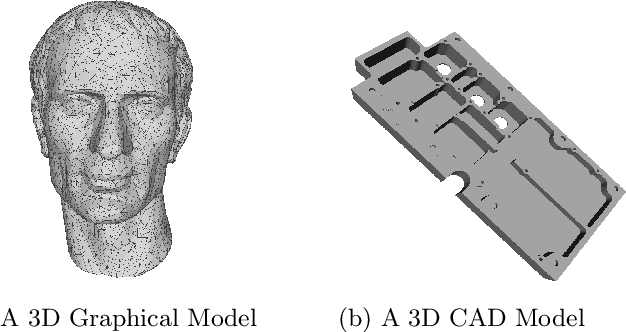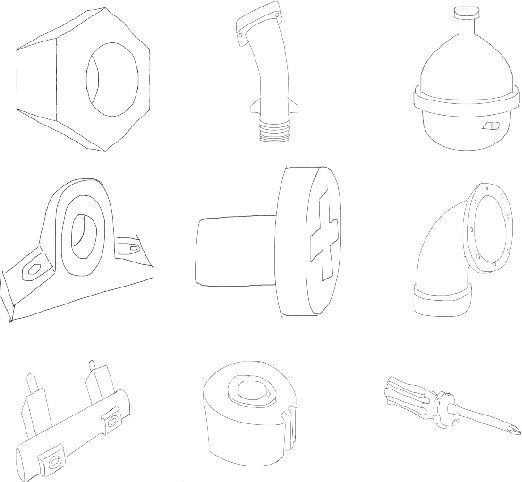Ramanathan Muthuganapathy
SketchCleanNet -- A deep learning approach to the enhancement and correction of query sketches for a 3D CAD model retrieval system
Jul 02, 2022



Abstract:Search and retrieval remains a major research topic in several domains, including computer graphics, computer vision, engineering design, etc. A search engine requires primarily an input search query and a database of items to search from. In engineering, which is the primary context of this paper, the database consists of 3D CAD models, such as washers, pistons, connecting rods, etc. A query from a user is typically in the form of a sketch, which attempts to capture the details of a 3D model. However, sketches have certain typical defects such as gaps, over-drawn portions (multi-strokes), etc. Since the retrieved results are only as good as the input query, sketches need cleaning-up and enhancement for better retrieval results. In this paper, a deep learning approach is proposed to improve or clean the query sketches. Initially, sketches from various categories are analysed in order to understand the many possible defects that may occur. A dataset of cleaned-up or enhanced query sketches is then created based on an understanding of these defects. Consequently, an end-to-end training of a deep neural network is carried out in order to provide a mapping between the defective and the clean sketches. This network takes the defective query sketch as the input and generates a clean or an enhanced query sketch. Qualitative and quantitative comparisons of the proposed approach with other state-of-the-art techniques show that the proposed approach is effective. The results of the search engine are reported using both the defective and enhanced query sketches, and it is shown that using the enhanced query sketches from the developed approach yields improved search results.
A learning-based approach to feature recognition of Engineering shapes
Dec 15, 2021



Abstract:In this paper, we propose a machine learning approach to recognise engineering shape features such as holes, slots, etc. in a CAD mesh model. With the advent of digital archiving, newer manufacturing techniques such as 3D printing, scanning of components and reverse engineering, CAD data is proliferated in the form of mesh model representation. As the number of nodes and edges become larger in a mesh model as well as the possibility of presence of noise, direct application of graph-based approaches would not only be expensive but also difficult to be tuned for noisy data. Hence, this calls for newer approaches to be devised for feature recognition for CAD models represented in the form of mesh. Here, we show that a discrete version of Gauss map can be used as a signature for a feature learning. We show that this approach not only requires fewer memory requirements but also the training time is quite less. As no network architecture is involved, the number of hyperparameters are much lesser and can be tuned in a much faster time. The recognition accuracy is also very similar to that of the one obtained using 3D convolutional neural networks (CNN) but in much lesser running time and storage requirements. A comparison has been done with other non-network based machine learning approaches to show that our approach has the highest accuracy. We also show the recognition results for CAD models having multiple features as well as complex/interacting features obtained from public benchmarks. The ability to handle noisy data has also been demonstrated.
'CADSketchNet' -- An Annotated Sketch dataset for 3D CAD Model Retrieval with Deep Neural Networks
Jul 20, 2021



Abstract:Ongoing advancements in the fields of 3D modelling and digital archiving have led to an outburst in the amount of data stored digitally. Consequently, several retrieval systems have been developed depending on the type of data stored in these databases. However, unlike text data or images, performing a search for 3D models is non-trivial. Among 3D models, retrieving 3D Engineering/CAD models or mechanical components is even more challenging due to the presence of holes, volumetric features, presence of sharp edges etc., which make CAD a domain unto itself. The research work presented in this paper aims at developing a dataset suitable for building a retrieval system for 3D CAD models based on deep learning. 3D CAD models from the available CAD databases are collected, and a dataset of computer-generated sketch data, termed 'CADSketchNet', has been prepared. Additionally, hand-drawn sketches of the components are also added to CADSketchNet. Using the sketch images from this dataset, the paper also aims at evaluating the performance of various retrieval system or a search engine for 3D CAD models that accepts a sketch image as the input query. Many experimental models are constructed and tested on CADSketchNet. These experiments, along with the model architecture, choice of similarity metrics are reported along with the search results.
* Computers & Graphics Journal, Special Section on 3DOR 2021
A Convolutional Neural Network Approach to the Classification of Engineering Models
Jul 14, 2021



Abstract:This paper presents a deep learning approach for the classification of Engineering (CAD) models using Convolutional Neural Networks (CNNs). Owing to the availability of large annotated datasets and also enough computational power in the form of GPUs, many deep learning-based solutions for object classification have been proposed of late, especially in the domain of images and graphical models. Nevertheless, very few solutions have been proposed for the task of functional classification of CAD models. Hence, for this research, CAD models have been collected from Engineering Shape Benchmark (ESB), National Design Repository (NDR) and augmented with newer models created using a modelling software to form a dataset - 'CADNET'. It is proposed to use a residual network architecture for CADNET, inspired by the popular ResNet. A weighted Light Field Descriptor (LFD) scheme is chosen as the method of feature extraction, and the generated images are fed as inputs to the CNN. The problem of class imbalance in the dataset is addressed using a class weights approach. Experiments have been conducted with other signatures such as geodesic distance etc. using deep networks as well as other network architectures on the CADNET. The LFD-based CNN approach using the proposed network architecture, along with gradient boosting yielded the best classification accuracy on CADNET.
PointTransformer for Shape Classification and Retrieval of 3D and ALS Roof PointClouds
Nov 08, 2020



Abstract:Effective feature representation from Airborne Laser Scanning (ALS) point clouds used for urban modeling was challenging until the advent of deep learning and improved ALS techniques. Most deep learning techniques for 3-D point clouds utilize convolutions that assume a uniform input distribution and cannot learn long-range dependencies, leading to some limitations. Recent works have already shown that adding attention on top of these methods improves performance. This raises a question: can attention layers completely replace convolutions? We propose a fully attentional model-PointTransformer for deriving a rich point cloud representation. The model's shape classification and retrieval performance are evaluated on a large-scale urban dataset - RoofN3D and a standard benchmark dataset ModelNet40. Also, the model is tested on various simulated point corruptions to analyze its effectiveness on real datasets. The proposed method outperforms other state-of-the-art models in the RoofN3D dataset, gives competitive results in the ModelNet40 benchmark, and showcases high robustness to multiple point corruptions. Furthermore, the model is both memory and space-efficient without compromising on performance.
 Add to Chrome
Add to Chrome Add to Firefox
Add to Firefox Add to Edge
Add to Edge